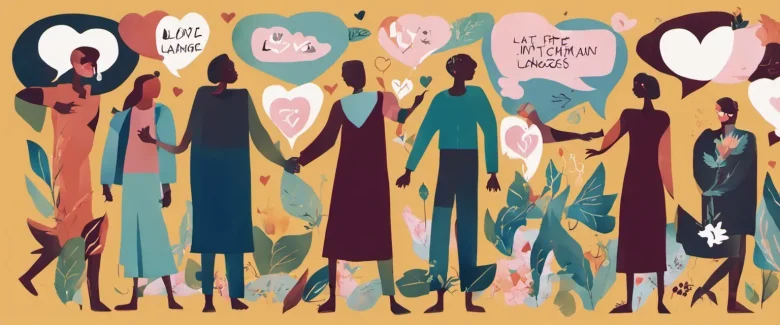In his transformative book, “The Five Love Languages,” renowned author and relationship counselor Gary Chapman delves into the profound impact that understanding and speaking the right “love language” can have on relationships. Chapman, with over 30 years of experience in counseling couples, guides readers through the five distinct love languages, helping them decipher and express their emotional affection effectively. With relatable examples and practical advice, Chapman empowers individuals to nurture their relationships and create lasting emotional connections. Through this engaging exploration, readers gain invaluable insights into their own love languages and those of their loved ones, illuminating a path towards deeper intimacy and fulfillment.
Chapter 1: Introduction to Love Languages
Chapter 1: Introduction to Love Languages of “The Five Love Languages” by Gary Chapman provides an overview of the concept of love languages and their importance in relationships.
Gary Chapman begins by explaining how everyone has a unique way of expressing and receiving love. He proposes that people primarily speak one of five different love languages, which include words of affirmation, acts of service, receiving gifts, quality time, and physical touch. Understanding and speaking the love language of our partner is crucial in maintaining a healthy and fulfilling relationship.
Chapman proceeds to describe the impact of not understanding each other’s love languages, which can lead to feelings of disconnect and unhappiness. He emphasizes the significance of learning to speak our partner’s language as an act of love rather than assuming they should understand our own. By understanding and adapting to our partner’s love language, we can effectively communicate love and build a stronger connection.
The author also addresses the misconception that love languages are exclusively related to romantic relationships. He emphasizes that love languages are applicable to all kinds of relationships, such as parent-child, siblings, friends, and coworkers, as they help convey care and affirmation.
Chapman presents a real-life example of a couple he counseled, where despite their genuine love for each other, they felt unloved due to different love languages. The example highlights the transformative power of identifying and embracing each other’s love languages to enhance their relationship.
In conclusion, Chapter 1 serves as an introduction to the concept of love languages, explaining their significance in relationships, consequences of not understanding each other’s languages, and how unlocking the mystery of love languages can transform and strengthen relationships.
Chapter 2: Words of Affirmation
In Chapter 2 of “The Five Love Languages” by Gary Chapman, titled “Words of Affirmation,” the author explores how verbal expressions of love can deeply impact our relationships. Chapman emphasizes that affirming words have the power to build up or tear down our partners, highlighting the significance of using these words effectively.
The author explains that words of affirmation are verbal expressions that communicate love and appreciation to our loved ones. It includes compliments, kind and encouraging words, words of gratitude, and words that show respect and acknowledgment for their efforts. Chapman argues that for individuals whose primary love language is words of affirmation, these words are vital for feeling loved and secure in a relationship.
Chapman illustrates the effects of positive and negative words through various examples and stories. For instance, he narrates the story of a woman named Gina who felt unloved and criticized by her husband’s constant negative remarks. Conversely, he presents the story of Joe and Sara, where Joe’s constant affirmations led Sara to feel cherished and loved. These examples highlight the significant impact that words of affirmation can have on our relationships.
The author also discusses the importance of quality over quantity when it comes to affirming words. He explains that sincere compliments and appreciation are essential, rather than simply using empty words to fulfill a sense of obligation. Chapman also advises identifying and verbalizing positive attributes and actions of our partners to strengthen the emotional connection.
In conclusion, Chapter 2 of “The Five Love Languages” emphasizes the power of words in affirming and uplifting our partners. It stresses the importance of meaningful, honest, and heartfelt compliments, appreciations, and expressions of love for individuals whose primary love language is words of affirmation. Additionally, the chapter emphasizes the need for genuine and consistent affirmation to foster healthy and fulfilling relationships.
Chapter 3: Quality Time
Chapter 3: Quality Time of the book “The Five Love Languages” by Gary Chapman explores the importance of spending focused and uninterrupted time with your loved ones as a means of expressing and receiving love. Chapman highlights that quality time is more than just being physically present; it involves giving undivided attention, engaging in meaningful conversations, and partaking in activities together.
The chapter begins by emphasizing that spending quality time with our loved ones is a vital aspect of any healthy relationship. Chapman explains that individuals have different preferences for how they receive love, and for those whose primary love language is quality time, nothing speaks louder than undivided attention. By dedicating time solely to our loved ones, we convey that they are important and valued in our lives.
Chapman provides practical advice on how to effectively communicate love through quality time. First, he suggests creating special moments without distractions, where both partners can bond emotionally and strengthen their connection. This can be achieved through activities like taking a walk, having a date night, or cooking a meal together. Chapman stresses the importance of turning off electronic devices and focusing solely on each other during these designated moments.
In addition, Chapman explores the concept of the “love tank.” Similar to a car’s fuel tank, every individual has an emotional love tank that needs to be filled regularly. Spending quality time is a crucial way of refilling this love tank and ensuring that the relationship remains strong and fulfilling.
By understanding the significance of quality time in the context of love languages, individuals can learn to better express their affection and meet their loved ones’ needs. Chapman concludes the chapter by encouraging readers to make a conscious effort to prioritize quality time, as it can greatly impact the quality and longevity of their relationships.
Chapter 4: Receiving Gifts

In Chapter 4 of “The Five Love Languages” by Gary Chapman, titled “Receiving Gifts,” the author explores the concept of giving and receiving gifts as a love language. Chapman emphasizes that for some individuals, receiving gifts is their primary way of feeling loved and appreciated.
The author clarifies that gifts are not necessarily materialistic items but rather symbolic gestures that reflect an individual’s love, thoughtfulness, and understanding of their partner’s needs and desires. When a person receives a gift corresponding to their love language, it speaks to their heart and strengthens the emotional bond in the relationship.
Chapman also discusses the significance of heartfelt gift-giving, explaining that the value lies in the thought and effort behind the gift rather than its monetary value. A thoughtful gift can communicate love, care, and understanding, making the recipient feel cherished and valued. Conversely, a lack of meaningful gift-giving, even when unintentional, can create feelings of neglect or unappreciation.
The chapter further explores how different individuals may have distinct preferences when it comes to receiving gifts. Some may appreciate surprises, while others prefer clear communication and guidance regarding their desires. Understanding a partner’s preferences and investing time and effort into selecting meaningful gifts can greatly enhance the emotional connection in a relationship.
To effectively express love through the language of receiving gifts, the author suggests observing and listening to one’s partner, paying attention to their desires and preferences. Chapman emphasizes the importance of giving from the heart with thoughtfulness and intention, as it shows that the partner’s needs and desires are valued, which is crucial for creating and maintaining a loving and fulfilling relationship.
Overall, Chapter 4 highlights and explains the significance of giving and receiving gifts as a love language, emphasizing the importance of thoughtful gestures and understanding one’s partner’s preferences for deepening emotional connections.
Chapter 5: Acts of Service
Chapter 5 of “The Five Love Languages” by Gary Chapman focuses on the concept of acts of service as a love language. Acts of service refer to doing things for your partner that express love and care. Chapman explains that for some individuals, actions speak louder than words, and their deepest emotional needs are met through acts of service.
According to Chapman, acts of service can take various forms, such as making your partner breakfast, doing household chores, or running errands on their behalf. These acts demonstrate love, thoughtfulness, and a willingness to alleviate their burden. For those whose primary love language is acts of service, these actions are deeply appreciated and fulfill their emotional needs.
Chapman highlights the importance of understanding each other’s love language within a relationship. For someone whose primary love language is acts of service, performing small tasks can speak volumes and make them feel loved and cherished. On the other hand, neglecting acts of service may lead them to feel unloved and unimportant.
He emphasizes that the key to effectively expressing love through acts of service is not simply performing tasks, but doing them with a willing and loving attitude, free from resentment or expectation of reciprocity. Acts of service should be done selflessly, focusing on your partner’s needs and desires.
Chapman also addresses the potential challenges in nurturing acts of service as a love language, such as balancing acts of service with personal boundaries and avoiding a sense of being taken advantage of. Additionally, he notes that effective communication regarding each partner’s needs and gratitude for their efforts is crucial for the success of acts of service as a love language.
Overall, Chapter 5 emphasizes the significance of acts of service in expressing love and meeting the emotional needs of individuals with this love language. It highlights the importance of recognizing and responding to this love language in order to cultivate a strong and fulfilling relationship.
Chapter 6: Physical Touch
Chapter 6 of “The Five Love Languages” by Gary Chapman focuses on the love language of physical touch and its importance in relationships. According to Chapman, physical touch is a powerful way to express love and it holds significant meaning for individuals who have this as their primary love language.
The chapter starts by explaining that physical touch doesn’t necessarily mean sexual intimacy; rather, it encompasses various forms of touch, such as holding hands, hugging, kissing, and even a gentle pat on the back. Physical touch can communicate emotions like love, comfort, and reassurance, making it a crucial aspect of human connection.
Chapman emphasizes that individuals with physical touch as their primary love language crave physical proximity and touch to feel loved and secure. He gives examples of how different couples express love through physical touch, including one partner’s desire for cuddling and the other partner’s need for regular massages. Understanding and meeting each other’s physical touch needs are essential to a healthy relationship.
The chapter also delves into the impact of touch on emotional and physical well-being. Research has shown that touch releases oxytocin, a hormone responsible for bonding and reducing stress levels. Regular physical touch can help foster emotional intimacy and create a safe and secure environment in relationships.
Chapman concludes the chapter by reminding readers that individuals express physical touch differently, and it is crucial to learn and understand the preferences and boundaries of one’s partner. He encourages couples to explore new ways of physical touch and to be mindful of the power of touch in building and maintaining a strong and loving relationship.
Overall, Chapter 6 outlines the significance of physical touch as a love language and emphasizes the importance of incorporating intentional and appropriate touch into relationships to create deeper emotional connections and foster love and intimacy.
Chapter 7: Discovering Your Love Language
Chapter 7 of “The Five Love Languages” by Gary Chapman focuses on helping readers discover their primary love language. Chapman explains that each individual has a primary love language through which they feel loved and appreciated. By understanding and communicating these languages, couples can enhance their relationships.
The chapter begins by emphasizing that love languages are not easily determined by simply observing how people express affection. Chapman explains that people tend to express love in the way they desire to receive it themselves. Therefore, understanding one’s own love language is crucial to effectively expressing love to others.
Chapman introduces the five love languages: words of affirmation, acts of service, receiving gifts, quality time, and physical touch. He details each one, providing examples and stories to help readers identify their own preference.
The author encourages readers to reflect on how their partners express love and which of the five languages resonates most with them. People often have a primary love language but may also feel love through secondary languages. Chapman urges readers to communicate their love languages to their partners to improve their relationship dynamics. He highlights the importance of both partners understanding each other’s love languages to meet each other’s needs effectively.
In summary, Chapter 7 of “The Five Love Languages” delves into the discovery and understanding of one’s primary love language. By identifying personal preferences and communicating them in relationships, individuals can foster better connections, expressing and receiving love more effectively.

Chapter 8: Applying the Love Languages
Chapter 8 of “The Five Love Languages” by Gary Chapman focuses on the practical application of the love languages in everyday life and relationships. After understanding the concept and importance of love languages, it is crucial to utilize this knowledge to enhance communication and connection with your partner.
Chapman suggests starting with an inventory, which involves reflecting on previous conflicts and observing patterns in your relationship. This helps to identify both your own and your partner’s primary love languages. Once identified, it is important to express love in your partner’s preferred language consistently, as well as make an effort to speak all five languages to some extent.
The author also emphasizes the importance of communication and understanding. Openly discussing each other’s love languages allows couples to better meet each other’s needs. Chapman also highlights the significance of adapting to change, as love languages may evolve over time or in different situations.
Furthermore, the book explores the concept of loving your partner even when they are at their worst, referring to this as unconditional love. It is crucial to understand that love languages are not just for romantic relationships but can also be applied to parental relationships, friendships, and even workplace interactions.
Chapman concludes the chapter by highlighting the positive impact that incorporating the love languages can have on relationships. By utilizing these tools, individuals can strengthen their connection with their loved ones and experience greater satisfaction and fulfillment in their relationships.
In summary, Chapter 8 is an insightful guide on applying the love languages in practical terms. By understanding and utilizing these languages, couples and individuals can foster stronger connections and create a more loving and fulfilling relationship or interaction.
After Reading
In conclusion, “The Five Love Languages” by Gary Chapman provides valuable insights into how individuals can communicate and express love effectively in their relationships. Chapman emphasizes the importance of understanding and speaking their partner’s primary love language, which include words of affirmation, quality time, receiving gifts, acts of service, and physical touch. By implementing these concepts, couples can deepen their connection and experience greater satisfaction in their relationships. Chapman’s book serves as a practical guide for improving communication and fostering a deep sense of love and compassion in all types of relationships.
1. “The Art of Loving” by Erich Fromm: This timeless classic explores the complexities of love and offers insights on how to cultivate healthy, fulfilling relationships. Fromm delves into the importance of self-love, overcoming the fear of loneliness, and understanding the different aspects of love, making it an essential read for anyone seeking a deeper understanding of relationships.
2. “Men Are From Mars, Women Are From Venus” by John Gray: This insightful book unravels the fundamental differences between the genders and sheds light on how these differences affect relationships. Gray provides practical advice on how to navigate the challenges that arise due to these differences, emphasizing communication and understanding as the keys to building successful relationships.
3. “The Seven Principles for Making Marriage Work” by John M. Gottman: Based on extensive research and years of clinical experience, Gottman offers a comprehensive guide on building strong and lasting marriages. Through his seven principles, he addresses key issues such as conflict resolution, nurturing emotional intimacy, and fostering trust. This book provides valuable tools to cultivate a happy and fulfilling marital relationship.
4. “Attached: The New Science of Adult Attachment and How It Can Help You Find – and Keep – Love” by Amir Levine and Rachel Heller: Drawing on attachment theory, “Attached” explores how our individual attachment styles affect our relationships. It offers valuable insights into understanding our own attachment style and that of our partners, helping us recognize and address common relationship challenges. This engaging book provides practical strategies to create and maintain healthy, secure connections in romantic relationships.
5. The Relationship Cure: A Five-Step Guide to Strengthening Your Marriage, Family, and Friendships” by John M. Gottman: Building on the principles explored in his earlier work, Gottman presents a comprehensive guide to improving all types of relationships. The book offers practical exercises, techniques, and strategies to enhance communication, build trust, and foster emotional connection. By following the five-step approach outlined in this book, readers can transform their relationships and experience deeper, more fulfilling connections.



